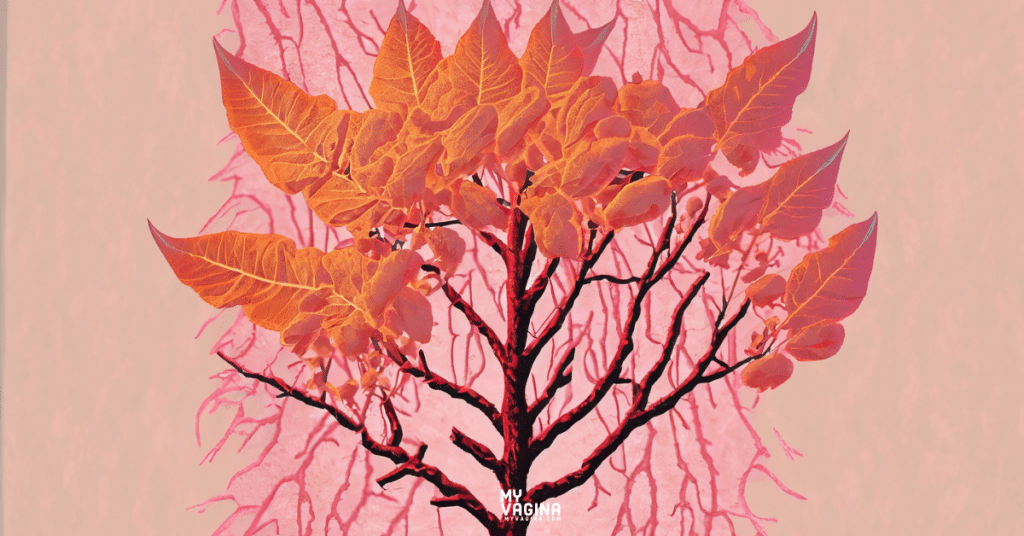Slippery elm bark powder can be used to make a mucilaginous substance that coats and protects vaginal cells. Slippery elm is also used in herbal medicine for the digestive tract, and is used orally and topically.
Slippery elm (Ulmus rubra) is prebiotic and anti-inflammatory.
Frozen gel pessaries
Add water to slippery elm powder and stir well, getting out any lumps, to make a thick gel (mucilage). Once you have your mixture, you can use a syringe to fill the pessary/suppository mould (bottom to top to avoid air gaps), then freeze.
When you need a refreshingly cool and soothing vaginal insert, pop the pessary out out of the mould squeezing from the bottom upwards, and use deep vaginally. Use as many as you like to get the desired effect.
If the pessaries are very frozen and stuck in the mould, warm the outside of the pessary to melt the outer layer a little so it slides out, or run quickly under hot water. You don’t want to melt the pessary, you just want it to detach it from the silicone mould.
Making a topical gel
To make a gel, use as much powder and water to make a gel of the consistency of your choice, and then use as needed topically on affected tissue. That may mean the anal area, perineum or vulva or any other skin that needs some soothing and protecting.
Applying gel deep vaginally
Use an applicator, 10ml syringe to apply the gel deep vaginally. Rinse the device well in hot water afterwards – the gel gets clingy, but rinses off well with plain water.
Use as often as needed to protect mucosal surfaces and ease symptoms.
Using slippery elm orally/as a tea for the urinary tract
To make a tea, use one teaspoon of slippery elm powder with a cup of hot water, stir well so all the lumps are out, and drink. Adjust the volumes according to your needs.
Firm slippery elm vaginal suppositories
To make the mixture, get slippery elm bark powder and mix it with water, but how much water matters – the more water, the less firm the pessary shape will be.
When only a little water is added, say equal parts powder and water, the bark powder becomes like dough, and can be formed into a solid shape that can be inserted vaginally.
Don’t make it too dry, or it’ll suck moisture from your tissues! But, not too wet that you can’t get it inside your vagina – this is a problem with this format, and is the least favoured.
Important tips for best use of slippery elm vaginally and orally
If you are using slippery elm, ensure there is sufficient water with it, or it will draw water from YOU to satisfy its thirst. Thus, it can be drying when used without sufficient water. If you’re using vaginally, keep it nice and wet.
If drinking or eating slippery elm, ensure to take away from food, medications or supplements, as it coats digestive linings and slows or prevents uptake of substances, including nutrients.
Speak to your practitioner if you are pregnant or breastfeeding before using slippery elm in any form. Take prescription medication two hours away from slippery elm.
Safety first, kids!
Slippery elm is well tolerated when used vaginally, however avoid if you are allergic, and use only with practitioner guidance if you are pregnant. If you have an adverse reaction, do not use slippery elm.
References1–3
- 1.Joo YE. Natural Product-Derived Drugs for the Treatment of Inflammatory Bowel Diseases. Intest Res. Published online 2014:103. doi:10.5217/ir.2014.12.2.103
- 2.Ried K, Travica N, Dorairaj R, Sali A. Herbal formula improves upper and lower gastrointestinal symptoms and gut health in Australian adults with digestive disorders. Nutrition Research. Published online April 2020:37-51. doi:10.1016/j.nutres.2020.02.008
- 3.Peterson CT, Sharma V, Uchitel S, et al. Prebiotic Potential of Herbal Medicines Used in Digestive Health and Disease. The Journal of Alternative and Complementary Medicine. Published online July 2018:656-665. doi:10.1089/acm.2017.0422





